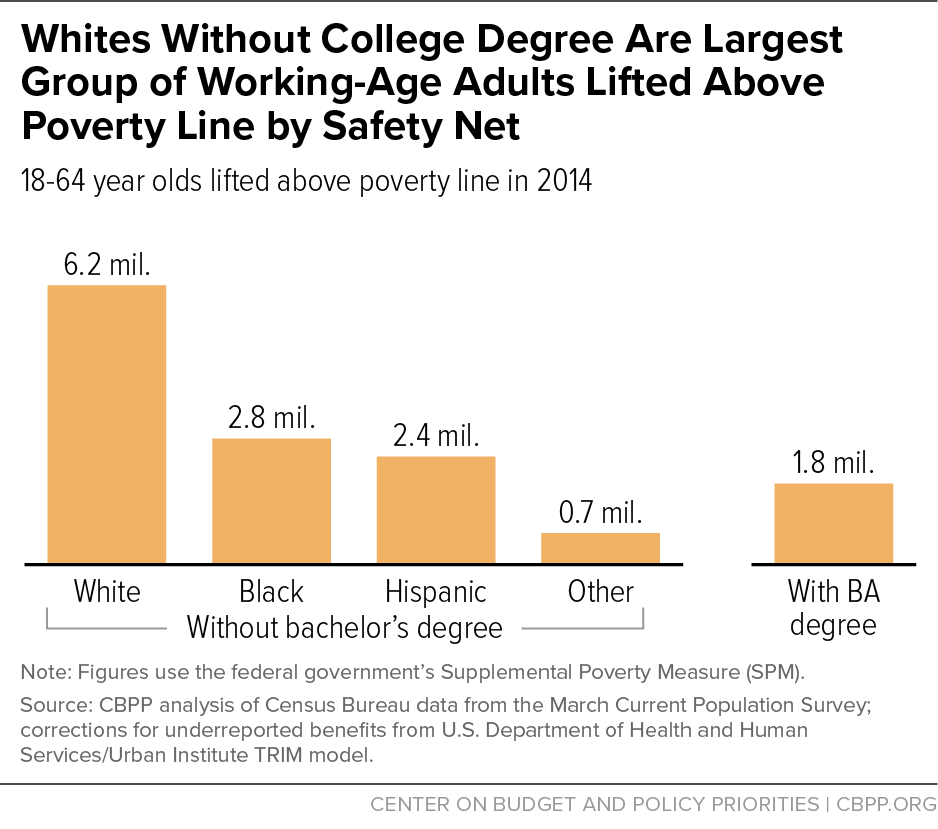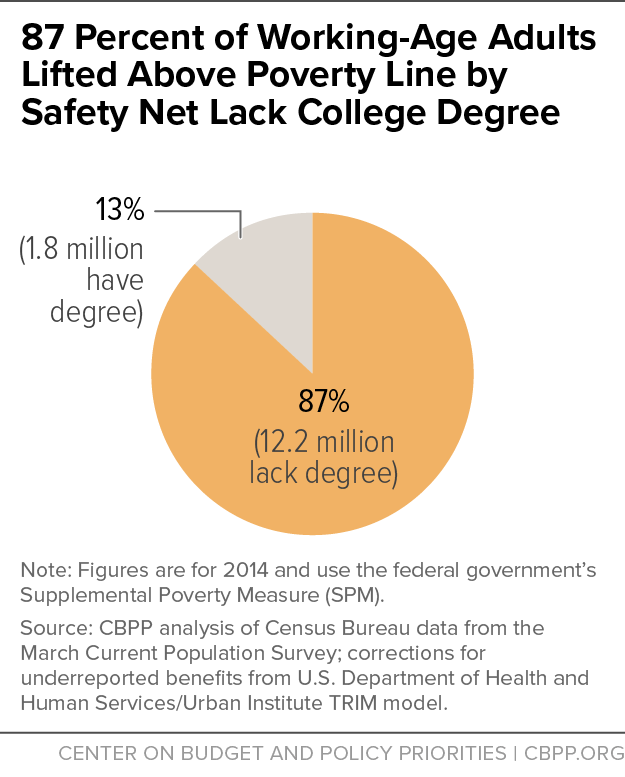- Home
- Poverty And Inequality
- Poverty Reduction Programs Help Adults L...
Poverty Reduction Programs Help Adults Lacking College Degrees the Most
Nearly 9 in 10 Working-Age Adults Lifted Above the Poverty Line Lack College Degree
Poverty reduction programs play a much more critical role in the economic security of working-age adults who lack a bachelor’s degree, including working-class whites, than they play for adults with a college degree. The nation’s poverty reduction programs provide extensive support to adults lacking a college degree, including working-class whites. Working-age adults without a degree, who are sometimes described as members of the working class, are far more likely than those with a degree both to have low incomes and to be lifted out of poverty by government policies or assisted by government health programs. As a result, when it comes to the potential this year for substantial cuts in poverty reduction programs and repeal of the Affordable Care Act, people without a college degree have the most at stake.
As this analysis shows, about 6 in 10 working-age adults lack a bachelor’s degree, but nearly 9 of every 10 adults whom government programs lift above the poverty line — or 12.2 million adults — are people lacking a degree. Similarly, the Urban Institute estimates that about 8 in 10 working-age adults who stand to lose health insurance if the Affordable Care Act is repealed — or 20.6 million adults — lack a degree.
People of all races and ethnic groups who lack a bachelor’s degree receive significant help from the safety net, but on two significant metrics, the results for white working-age adults stand out. Among working-age adults without a college degree, 6.2 million whites are lifted above the poverty line by the safety net — more than any other racial or ethnic group. (See Figure 1.) In addition, the percentage of people who would otherwise be poor that safety net programs lift out of poverty is greater for white working-age adults without a college degree than for other adults without a college degree. Still, poverty rates among people without a college degree are substantially higher for blacks and Hispanics than for whites — whether or not safety net assistance is considered.
These findings are particularly noteworthy because the election has brought increased attention to the economic difficulties that people without a college degree can face. Largely overlooked in the discussion of these issues to date, however, is the fact that the nation’s poverty reduction programs provide extensive support to adults lacking a college degree, including working-class whites, and that such people would be the principal losers under various proposals to cut these programs that may emerge in coming months.
Methodology and Definitions
This analysis examines working-age adults (aged 18 to 64) who are not full-time students and live in families where no one has a bachelor’s degree. These people might not have graduated from high school, might have completed high school but not gotten more education, or might have some college experience, such as at a community college, but not have received a four-year bachelor’s degree. We use the term “adults without a college degree” to denote such individuals. We refer to adults aged 18 to 64 who do have a bachelor’s degree, or who live in a family with someone else who has a bachelor’s degree, as “adults with a college degree.”
We use the terms “white,” “black,” and Hispanic as shorthand for the mutually exclusive categories of “non-Hispanic whites,” “non-Hispanic blacks,” and “Hispanics of any race.”
To measure poverty, we use the Supplemental Poverty Measure (SPM), which more fully assesses the role of taxes and transfers on economic status than the official poverty measure does. The government programs that the SPM counts include both cash and near-cash benefit programs and refundable tax credits (but not health insurance programs). Given the importance of non-cash assistance such as the SNAP program (formerly known as food stamps), analysts across the ideological spectrum favor the inclusion of such programs in poverty estimates.
The primary data source for this analysis is the Census Bureau’s March Current Population Survey (CPS). We also use data from the Urban Institute’s TRIM model to correct the Census data for underreporting of government benefits; some families don’t report all the benefits they receive when responding to Census Bureau questions. The latest year for which such Urban Institute data are available is 2014, so that is the year we examine.[1]
Poverty Before Government Benefits Far Higher Among Those Without College
Poverty rates are far higher among working-age adults without a college degree than among such adults with it. (See Table 1.) This difference reflects the wide earnings and employment discrepancies between people with and without a degree, which have grown considerably in recent decades. Taking a look first at the extent of poverty before taking government benefits and tax credits into account, we find that:
- The poverty rate before taking income from government programs into account is more than three times higher among working-age adults without a college degree (30.4 percent) than among other adults (8.7 percent).
- Nearly 1 of every 3 working-age adults without a college degree is poor before government benefits and tax credits are taken into account. Poverty rates are lower for white adults without a college degree than for other adults without a degree; nonetheless, 1 in 4 white adults who lack a degree is poor before accounting for government benefits and tax credits.
- Finally, more than 4 of every 5 adults who are poor before the effects of government transfers and taxes are taken into account — 31.2 million working-age adults — live in a family where no one has a college degree.
| TABLE 1 | ||||||
|---|---|---|---|---|---|---|
| Number and Percent of Working-Age Adults in Poverty Before and After Government Benefits and Taxes, 2014 | ||||||
| No One in Family Has a Bachelor's Degree | At least one person has a BA | |||||
| White | Black | Hispanic | Other | Total | ||
| Working-age population (18- to 64-year-olds, in millions) | 57.9 | 15.1 | 23.9 | 5.9 | 102.8 | 77.0 |
| In poverty, before government assistance and taxes | 14.1 | 6.5 | 8.6 | 2.0 | 31.2 | 6.7 |
| In poverty, after government assistance and taxes | 7.9 | 3.7 | 6.3 | 1.3 | 19.1 | 4.9 |
| Lifted above poverty line by government assistance and taxes | 6.2 | 2.8 | 2.4 | 0.7 | 12.2 | 1.8 |
| Pre-government poverty rate | 24.3% | 43.1% | 36.2% | 33.6% | 30.4% | 8.7% |
| Post-government poverty rate | 13.6% | 24.4% | 26.2% | 21.3% | 18.5% | 6.4% |
| Percent lifted above poverty line by government assistance and taxes | 44% | 43% | 28% | 37% | 39% | 27% |
Source: CBPP analysis of Census Bureau data from the March Current Population Survey; corrections for underreported benefits from U.S. Department of Health and Human Services/Urban Institute TRIM model.
Poverty Reduction Programs Especially Benefit Those Without a College Degree
Safety net programs are particularly beneficial for adults without a college degree. The vast majority of working-age adults lifted above the poverty line by government benefits and tax credits are people lacking a college degree.
- The safety net lifted 12.2 million working-age adults without a college degree out of poverty in 2014, and benefited another 11 million people who live in these adults’ families. In contrast, the safety net lifted 1.8 million adults with a college degree out of poverty that year. While adults lacking a college degree constituted 57 percent of all adults, they constituted 87 percent of the adults whom safety net programs lifted above the poverty line (figure 2).
-
The safety net lifted out of poverty 39 percent of working-age adults without a college degree who would otherwise be poor; it reduced their poverty rate from 30.4 percent before government benefits and taxes to 18.5 percent after those transfers. By comparison, it lifted 27 percent of otherwise-poor adults who have a college degree out of poverty. It reduced their poverty rate from 8.7 percent before government benefits and taxes to 6.4 percent after such support is taken into account.
Poverty reduction programs provide substantial benefits to all demographic groups within the working class. But they reduce poverty proportionately more among working-age white adults without a college degree than among other adults lacking a college degree. Among otherwise-poor adults, these programs reduced poverty by 44 percent for white adults and by 35 percent for all other adults.
- The safety net lifted 6.2 million working-age white adults without a college degree out of poverty in 2014, reducing their poverty rate by more than two-fifths — from 24.3 percent (before considering the safety net’s effects) to 13.6 percent. About half of all working-age adults without a college degree whom safety net programs lift out of poverty are white.
- The safety net reduces poverty substantially among other groups, as well. In 2014, it reduced the poverty rate for working-age black adults who lack a college degree from 43.1 percent before government benefits and taxes to 24.4 percent after the benefits and taxes are taken into account; this represents the largest percentage point reduction in poverty among the groups examined. Still, poverty rates are significantly higher among people of color than whites both before and after government benefits and taxes are taken into account.
Among working-age adults, Social Security, SNAP, two refundable tax credits (the Earned Income Tax Credit and the Child Tax Credit), and the Supplemental Security Income program for poor people who are elderly or have disabilities all have their largest effects in reducing poverty among those without a college degree.
Health Care Benefits Also Disproportionately Help Those Without a College Degree
These data do not consider health benefits when examining the effect of government benefits and tax credits on poverty. Other data clearly show, however, that government health insurance benefits, as well, are of disproportionate benefit to working-age adults without a college degree. Of particular note, a recent Urban Institute analysis estimates that 25.8 million working-age adults will lose health insurance coverage in 2019 if the Affordable Care Act (ACA) is repealed; some 20.6 million, or 80 percent of these individuals, are people without a college education.[2] Our calculations based on the Urban Institute data also suggest that roughly half of those without a college education who would lose health insurance are white.[3]
In short, people with low or modest incomes who lack four-year college degrees are those most likely to be adversely affected by the substantial changes and reductions in health insurance and other safety net programs that Congress is likely to consider this year.
Commentary: Signs Suggest Trump Budget Will Feature Unprecedented Cuts Plus Large Tax Cuts Favoring Wealthy
End Notes
[1] We correct for the underreporting of three government assistance programs — the Supplemental Nutrition Assistance Program (SNAP, formerly known as food stamps); Supplemental Security Income (SSI); and Temporary Assistance for Needy Families (TANF) — and use TRIM’s estimate of the value of housing assistance, including rental vouchers and public housing. The corrections use baseline data from the Transfer Income Model Version 3 (TRIM 3) policy microsimulation model developed and maintained by the Urban Institute with primary funding from the U.S. Department of Health and Human Services’ Office of the Assistant Secretary for Planning and Evaluation. In assessing Earned Income Tax Credit (EITC) receipt, we use data from the Census Bureau’s tax model adjusted to exclude undocumented immigrants who are not eligible for the EITC.
[2] Linda J. Blumberg, Matthew Buettgens, and John Holahan, “Implications of Partial Repeal of the ACA through Reconciliation,” Urban Institute, December 2016, http://www.urban.org/research/publication/implications-partial-repeal-aca-through-reconciliation. These data use a slightly different categorization than we use here. The Urban Institute looks at the education level of each individual adult; our analysis looks at the educational level of individual adults but also examines whether they live in a household where someone else has a college degree.
[3] These data show, as well, that uninsurance rates for people of all races and ethnicities will increase by at least 50 percent if the ACA is repealed (these Urban Institute breakouts include people of all ages). Among whites it increases by 150 percent; the percent of whites lacking insurance jumps from 7 percent under the ACA to 18 percent under repeal.
More from the Authors

Recent Work:



